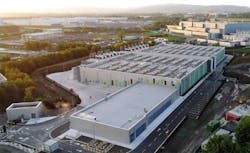Four Key Considerations for Powering Large Industrial Facilities
That's why it's critical to have a comprehensive understanding of your power needs before you start building. This article explores the key considerations every facilities team will need to manage.
Get to know your local power provider. It starts with getting to know your local power provider and their guidelines for the type of facility you’re building. This is where the real challenge begins.
Although there are several global and local standards (IEEE, NESC, NEC, etc.) that are utilized by all electric utility providers, there are also other design, maintenance, and protection standards that can vary by company that are more utility specific. Understanding those requirements is essential for a successful project.
When ensuring that all of the national, local, and utility-specific requirements are being met, while providing a design that may include multiple power sources, transformers, and services dedicated to a project, even the most experienced facilities team may struggle to keep up.
Identify redundancy needs on the front end. Another key component of a power strategy for any facility is understanding the need for redundancy. Many industrial facilities, like hospitals and airports, require large amounts of power and 24-hour daily operation. That means they have to add built-in redundancies to ensure that there is no loss of that power in order to maintain and provide the services they offer to the public.
Gas-powered generators only provide temporary power to these facilities during a limited outage. A more consistent, longer-term option is the use of multiple electrical source feeds into the facilities and the installation of either manual or automatic switchgear. The installation of switchgear allows for electricity to be switched between two or more sources to ensure that power remains on at all times, and reduce the need for generators to provide alternate power options for the facility.
For the owner, the decision will ultimately come down to how quickly the alternate power sources need to be available and how much money should be invested to assure that type of system. Both manual and automatic switchgears will accomplish the need for redundant power. The big differences in the two comes down to how long it takes to switch from one source to another and how much money the owner is willing to spend to ensure a faster response when switching between those sources.
Redundancy is not just about the external factors. Inside the plant, you'll have dozens of unit substations scattered throughout the facility, each with their own set of circuit breakers. And because downtime is not an option, you need to have a plan in place for switching the load of any of the unit substations from one breaker to another if one of the breakers goes down.
Consider the impact of weather. One of the most critical decisions you’ll need to make is choosing between open bay breakers or a metal-clad switchgear building for your high-voltage transformers. While metal-clad breakers may be less susceptible to extreme weather events, if they do go down, it can impact your entire plant’s production. On the other hand, a open bay breakers offer equal protection but may not be ideal for areas prone to extreme weather.
Factor in containment strategies. When handling and maintaining high-voltage transformers, you need to be prepared for a number of things unrelated to the power supply. For example, transformers require a large amount of mineral oil to operate efficiently; therefore, a secondary containment design and plan for that oil must be designed in order to meet the requirements of the United States Environmental Protection Agency.
In short, building a major industrial facility is no easy feat. It requires a team that understands not only your external electric needs but also the requirements of the facility, both inside and out. So, before you start digging into the design phase of your project, make sure you have the right team in place to ensure a successful outcome. Planning for these needs ahead of time will help to ensure the projects are successful and that the services they are providing meet or exceed their expectations and those of the people that they serve.
About the author: Rick Yeager has nearly three decades of utility design experience servicing a diverse portfolio of clients, including industrial plant owners, for-profit and cooperative utilities, broadband providers, and state departments of transportation. As utility services practice leader, Rick oversees Gresham Smith’s growing utility design, coordination, and inspection group, which includes disciplines dedicated to electrical, natural gas, communications, and water/sewer.
Rick has served as project manager and senior designer for more than 150 electric transmission, distribution, and substation projects. His expertise includes field inventory, preliminary research and planning, make-ready engineering, specification development, design and detailing of drawings, field engineering, survey and staking, coordination with other utilities on the project, and development of accurate construction estimates as well as construction, engineering, and inspection (CEI) services.
About Gresham Smith: Gresham Smith is an architecture, engineering, and design firm with more than $290 million in annual gross revenue and 26 offices across the United States. The firm provides full-service solutions for the built environment with a focus on the aviation, building engineering, healthcare, industrial, land planning, life and work places, transportation, and water and environment market sectors. Our team of designers, creative problem-solvers, planners, and collaborators work closely with our clients to improve the cities and towns we call home. Learn more at GreshamSmith.com.

